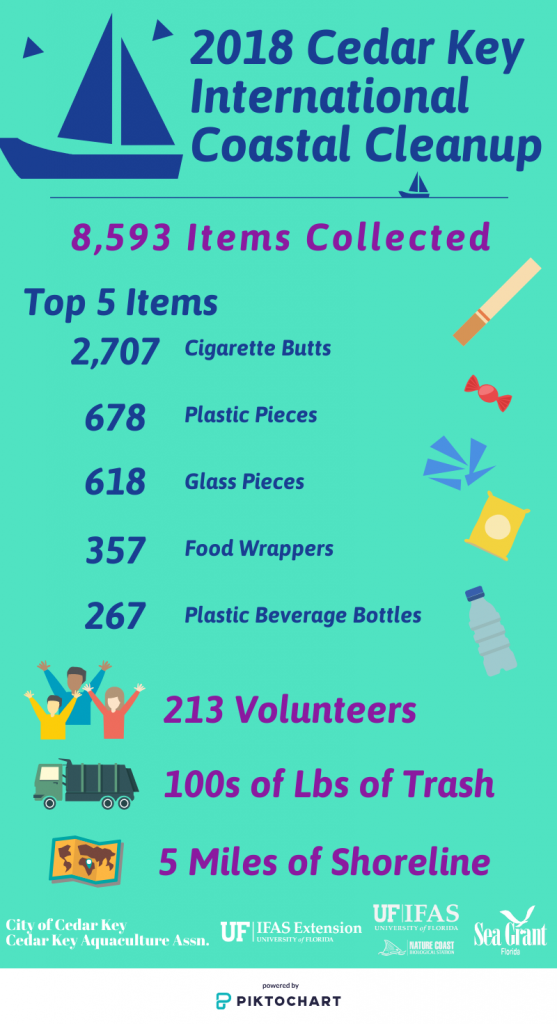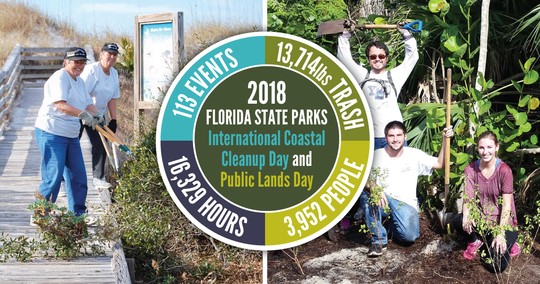Right now, Hurricane Michael is barreling toward northwest Florida. Rightly so, the #1 priority for people is to prepare their home and business and stay safe. I evacuated my office earlier today and am sitting safe in Gainesville, hoping the storm loses steam and that my friends, colleagues, and family stay safe. But I am also thinking about other possible negative impacts of hurricanes. One of the well-known impacts of hurricanes is the amount of debris generated by the wind and surge that confronts the coast. Cedar Key, like many coastal communities, just completed an International Coastal Cleanup event. The results of this cleanup are described below. But as I write this, I am very cognizant of the fact that in a day and a half, Cedar Key and other communities will likely be cleaning up again. If you want to help with the Hurricane Michael cleanup effort, stay tuned on Facebook and other channels for updates on how you can help. In the meantime, read on for more about the fair-weather cleanup we conducted with the help of hundreds of amazing volunteers last month.
Record numbers at 2018 Cedar Key Cleanup
On September 15, 2018, over 200 volunteers from Cedar Key and surrounding communities participated in the Cedar Key International Coastal Cleanup event. Volunteers came from far and wide, especially Gainesville, to clean up Cedar Key’s shorelines. Volunteers cleaned up trash along shorelines by boat and on foot. The event lasted from 7 am to 1 pm. The total count of 213 volunteers marks a record high number for Cedar Key’s event. Likewise, the total number of items collected (8,593) marks a record high amount of debris. But is this something to celebrate?

Of course, it is excellent to see so many folks show support for the marine environment by donating their time! We are very grateful to all of the volunteers who helped the community’s effort to clean up harmful debris. This year, more hands meant that more debris was cleared from the shoreline. So, part of the upward trend in trash collected could be simply due to having more help. But could there be something bigger at work? And, why is there so much trash to pick up in the first place?
Statewide debris and global trends

The Florida Park Service reports that volunteers removed over 14,000 pounds of trash from public lands during their International Coastal Cleanup events. While this is quite an accomplishment, it also speaks to the concerning amount of trash littering public lands. Florida’s State Parks and public lands are tended by staff and volunteers who, presumably, pick up litter as part of their regular duties. The Florida Parks Service reports that more than 14,400 volunteers donate approximately 1.2 million hours per year tending the parks and natural areas. It is concerning that the data show thousands of pounds of trash accumulating on an annual basis despite the efforts of these volunteers. How can this happen?

Globally, International Coastal Cleanup data shows that plastic items are increasingly common in shoreline cleanups. Scientific studies of marine debris show mixed results regarding trends in the amount of trash entering and remaining in the oceans [1,2,3]. One thing is for sure, the amount of trash in our ocean is staggering. The best available science suggests that inputs of plastic, especially single-use consumer plastic, to our oceans will increase with time. Much of the plastic that enters the ocean either sinks, breaks up into tiny pieces, or is lost to other sources, possibly our shorelines. Results from marine debris surveys also suggest, not surprisingly, that the highest amounts of debris are found closer to areas with higher population. So it’s definitely possible that the large amount of trash we continue to see pile up on our shorelines has something to do with global trends. But it’s also true that local actions can help!
What to do?
If you want to be part of the solution, you can start by reducing or eliminating single-use plastics from your daily life. You can get started by skipping straws or other items, and expand out from there. You can also make sure you discard of trash responsibly in coastal areas. Never place trash or recycling in overflowing bins as it’s likely to blow away and end up in a nearby waterway. Favor lidded trash cans and recycling bins when discarding of trash. And, of course, help out a shoreline near you by picking up trash during annual cleanup events or regular beach visits. You can #BeTheSolution and help #BeatPlasticPollution!
- J.R. Jambeck, R. Geyer, C. Wilcox, T.R. Siegler, M. Perryman, A. Andrady, R. Narayan, K.L. Law. 2015. Plastic waste inputs from land into the ocean. Science, 347:768-771
- J.A. van Franeker, K.L. Law. 2015. Seabirds, gyres and global trends in plastic pollution. Environmental Pollution, 203: 89-96
- M. Eriksen, L.C.M. Lebreton, H.S Carson, M. Thiel, C.J. Moore, J.C. Borerro, et al. 2014. Plastic pollution in the world’s oceans: More than 5 trillion plastic pieces weighing over 250,000 tons afloat at sea. PLoS ONE 9: e111913.
 0
0
